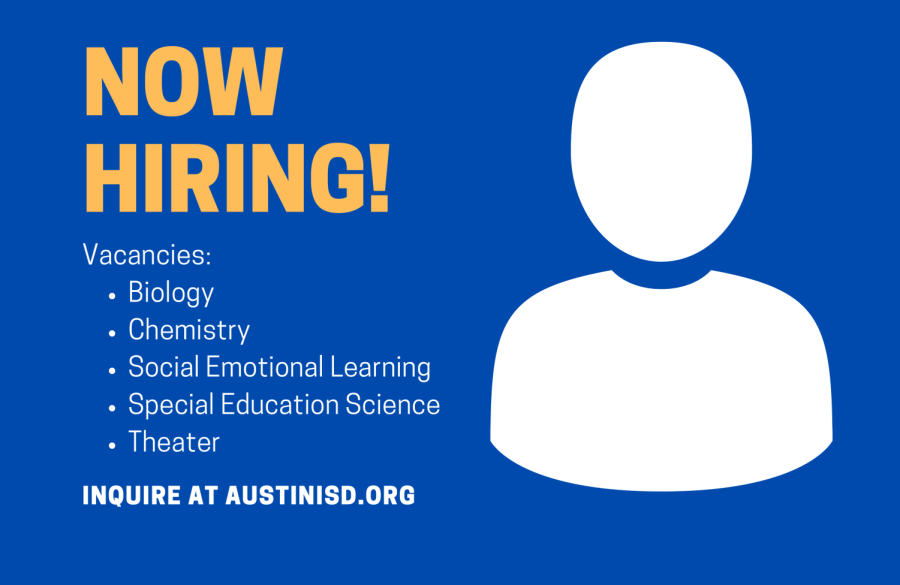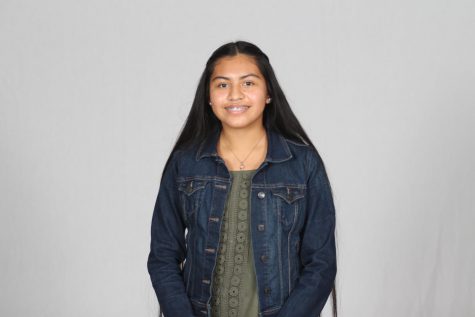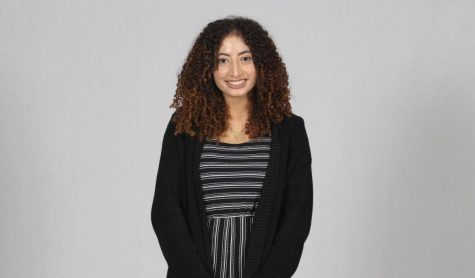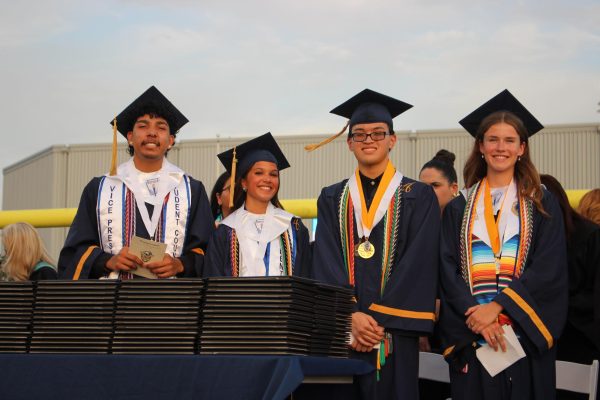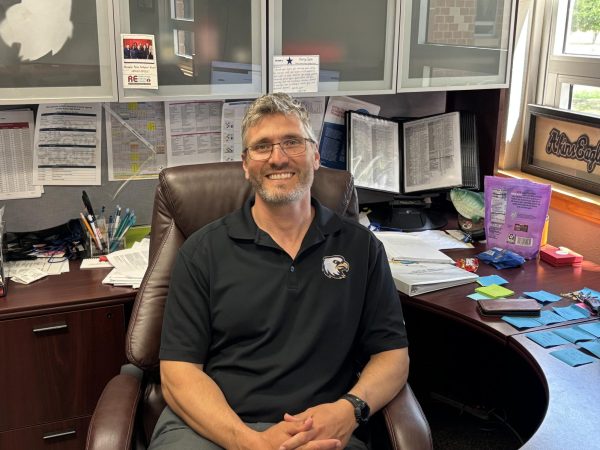Workforce shortages leave students without teachers
A list of job openings due to the staff shortage
November 19, 2021
After more than three months into the school year, there are still hundreds of students at Akins without permanent teachers.
Based on the typical teacher workload, 1,000 students could be affected by the shortage, meaning that each one of them could be without a permanent teacher for at least one of their class periods.
There are currently six full-time teacher vacancies: biology, chemistry, social-emotional learning, special education science, and two positions in the theater department. Part of the shortage can be attributed to the nationwide shortage of workers.
According to the U.S. Labor Department’s monthly Job Openings and Labor Turnover Surveys, there were 10.4 million job openings in August, while the number of people leaving their jobs (also called the “quits rate”) rose to 4.3 million. This is the highest level seen on records dating back to December 2000.
Associate Principal Manuel Garcia said that the national shortage of workers has made its way into the education industry.
“There’s a lot of companies that are moving in like Tesla, Apple, Google, Facebook … so there’s a lot of openings,” he said. “So teachers, you know, if there’s an opening and it’s a job they can probably work from home, they will probably want to do that instead of coming to deal with being with students and maybe getting exposure to COVID whereas they just work from home for Google or Facebook.
Garcia said that administrators were aware of the shortages before the school year started.
“There’s a lot of vacancies at the beginning of (most years),” he said. “And eventually they get filled, but this year has been a bit more difficult to find teachers. Even when we find teachers, they come here, they’re brand new, and they say, ‘Oh, this is so hard.” And then they don’t stay here.
To recruit teachers, Garcia said that the district has been going to job fairs. He said that some obstacles to finding teachers have been the fact that nobody’s applying and the high cost of living in Austin.
“When you look at Austin ISD, it’s hard to find new teacher applicants because the cost of living is often very expensive. The average salary of a teacher is $55,000, which is like they can’t even afford to live in Austin,” he said. “So if a teacher has a spouse or husband or wife, they may be able to afford to live in Austin, but it just can’t be a teacher’s salary.
“Garcia said that department chairs and instructional coaches have been working very hard to provide some continuity by setting up BLEND modules.
“For example, if there’s a biology teacher that’s out, then all of the biology teachers use the same BLEND modules. So they all share them. And then they take it to that substitute. We’ve been trying to hire permanent substitute teachers that are able to help with that as much as possible. And there is a shortage of substitutes, as well,” he said.
To ensure that students who don’t have a permanent teacher will be ready to take any required final exams, Garcia said that students will be given a review packet ahead of time.
“All the biology teachers, all the Algebra 1 teachers, most of the time they all use the same final exam,” Garcia said. “Students are going to get opportunities to do the review packet, to do open-notebook tests. So it has to do with opportunities not to fail. And that’s not fair to fail the student if there hasn’t been a permanent teacher in the classroom. We do everything we can to help support the students and not penalize them,” he said.
As for making sure that students are ready to take required STAAR exams, Garcia said that Akins will be doing STAAR test preparation camps.
Math Department Chair Christopher Aguilar said that the math department was fully staffed at the beginning of the year, but it lost a teacher when they resigned.
“There were other subjects that were short on teachers, but math was good. We started the year just fine, and then we lost that one teacher. We’ve been trying to fill it ever since, but it just hasn’t happened,” he said.
Aguilar said that he knows that it is not ideal for kids to be sitting in classrooms without a teacher. This is because students need to be taught new lessons or someone to answer their questions.
“The best-case scenario is to have a teacher in that room teaching those kids what they need to be taught,” he said.
Aguilar said that for students, one advantage they have is that Akins is a Standards-Based Grading campus, which allows students to revise their work later.
“Since we are an SBG campus, it’s never too late to go back in and fix grades,” he said. “So even if these kids aren’t happy with their grades that they’ve gotten, we can always go back in and reteach and redo those things and get them caught up.
” Science Department Chair Christina Jenschke said that there were 605 students without a science teacher after the 9-week mark.
“These students were provided with assignments and content from the generosity of the department teachers stepping in to help as it was too overwhelming for me to handle alone,” she said. “The district provides a curriculum with the blueprint but these have to be modified and published every day by someone along with making copies that support the curriculum.” Substitute teacher Mitchell Abbott has been at Akins for over a month, first subbing for a biology class, then was moved to teach a chemistry class of mostly juniors and seniors.
He said that he’s faced many challenges as a permanent substitute teacher.
“It has been difficult because for both the assignments, I came in a while after the teacher had left, so it was really difficult to figure out where they were supposed to be and then where they actually were in their lessons that the students needed to be caught up,” he said. Abbott said that he has a good amount of access to student information and platforms that teachers use.
“I’ve been on my own as far as figuring out lesson plans. I get some stuff from the district then I have to modify it to fit where they are and then combine things to play catch up,” he said.
As for what it’s been like learning the material alongside the students, Abbott said that the material is familiar since his degree is in engineering.
“My chemistry courses in college were accelerated, so I didn’t go in-depth, but I did it really fast,” he said. “So everything’s been familiar, I just have to relearn the details. With high school, it’s different as there are specific learning objectives that the district sets out to create,” he said. “It hasn’t been so much learning as it has been refreshing my memory of chemistry.
”Abbott said that he’s currently about to start his alternative certification program for teaching and is ideally trying to get a job as a teacher at Akins or another school. “At the moment, I can’t be hired,” he said. “I think I’m going to stick around more as a sub, but it’s gonna be a while until I’m fully certified and can be hired.
”Students have been heavily impacted by the teacher shortage. Sophomore Brenden Kelly said that it’s frustrating to have three classes without teachers.
“In geometry, we do not do anything, we just sit there for two hours because of Eagle Time, and it is my first period,” Kelly said. “Even though there is a substitute in my professional communications class, we do not do anything. Lately, the substitute that we got is trying to help us. And in physics, we have a kind of permanent substitute, where we’ve been doing work but nobody is paying attention.
”Sophomore Diego Hernandez said that the teacher shortage has been difficult for him.
“At first, they just gave us really good grades as an automatic grade, but then after a while, they gave us work on the BLEND (system) and because we did not know much of the stuff, it was kind of difficult,” Hernandez said.
Hernandez is worried about what will happen when final exams approach.
“I was thinking about how we have to take final exams and we don’t have a teacher to teach us, and we’re going to get behind,” Hernandez said.
Izaak Mireles and Brandon Llanos contributed to this story.



